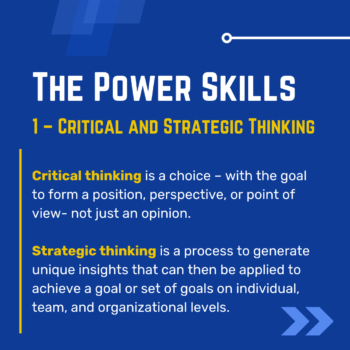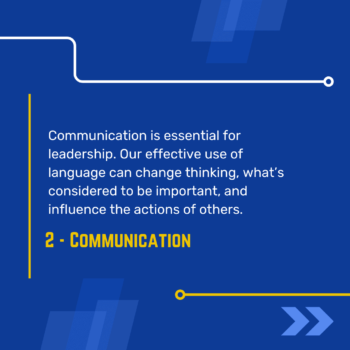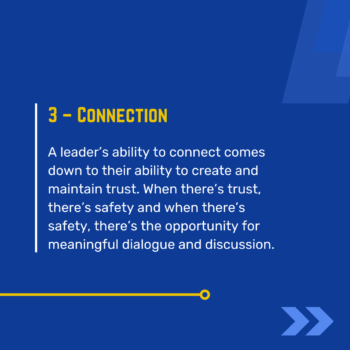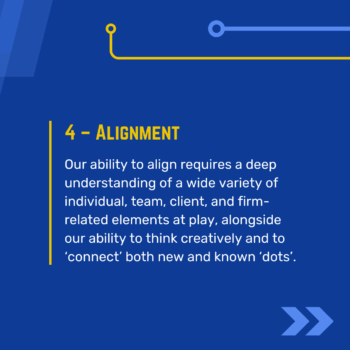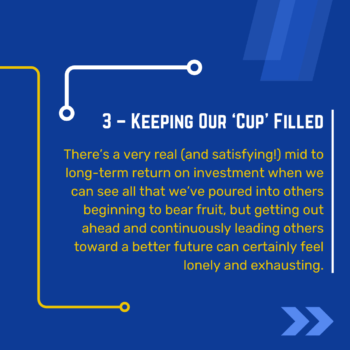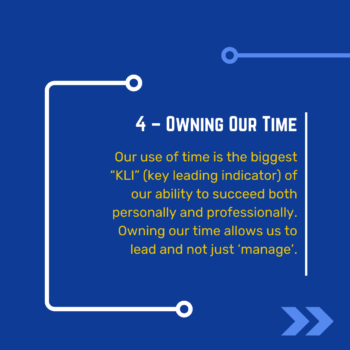Essential Power Skills and Habits for Next-Level Leadership
Essential Power Skills and Habits for Next-Level Leadership
There’s a lot coming at us in terms of technology, consolidation, and business model evolution – and all this on the heels of profound workplace, marketplace, and recruiting space change.
How are the highest performing leaders (and leadership teams!) getting ahead, addressing needs, and unlocking opportunities?
They are leveraging (and continuously refining) what I call the “essential power skills and habits”.
When practiced, these are proficiencies related to both thinking and action that lead directly to next-level success.
“Understanding, leveraging, and refining the ‘essential power skills and habits’ is our best path for achieving new levels of growth and prosperity during this time of great change.”
– Peter C. Atherton, PE
A summary and brief description of each is provided below:
THE POWER SKILLS
Power skills are the developed abilities necessary for achieving new era growth and prosperity.
Power Skill 1 – Critical and Strategic Thinking
This skill is so fundamentally important that I designed a special two-part podcast episode series to address it in more detail (which you can link to below).
In essence, critical thinking is a choice – a choice to create time and space to analyze facts in a rational and self-disciplined, directed, and monitored way with the goal to form a position, perspective, or point of view- not just an opinion.
In many ways, critical thinking is about personal leadership and drive to discover truth and facts and find the ‘why’ behind what’s happening so that we can credibly and effectively engage with others to refine our understandings and analyses prior to taking any next steps.
Strategic thinking relies on critical thinking and is as much ‘art and skill’ as it is a choice.
Strategic thinking is a process to generate unique insights that can then be applied to achieve a goal or set of goals on individual, team, and organizational levels. Strategic thinking is also as much about synthesis as it is analysis and helps us to consider how certain facts and insights could work together to produce better results.
Critical and strategic thinking is especially important with the overwhelming volume of information (and misinformation) before us, declining attention spans, and yet still very real opportunities and consequences. Our ability to think deeper and move beyond the headlines and our current trajectory is the best way to help ensure future success.
Power Skill 2 – Communication
Communication is essential for leadership. In fact, it is a primary component of one of the five things that only leaders can and must do.
Communication is the exchange of information between individuals and can be in the form of language, symbols, or behavior, and the way in which they are used can be powerful.
Our effective use of language can change thinking, what’s considered to be important, and influence the actions of others. Our behaviors demonstrate what we value (or are ‘valuing’) and are most often mirrored by those around us.
Power Skill 3 – Connection
Our ability to effectively communicate begins with our ability to connect. Without a positive connection, there is no ability to move another person toward a different thought, feeling, or action.
“Our ability to effectively communicate begins with our ability to connect. Without a positive connection, there is no ability to move another person toward a different thought, feeling, or action.”
–Peter C. Atherton, PE
A leader’s ability to connect comes down to their ability to create and maintain trust.
When there’s trust, there’s safety and when there’s safety, there’s the opportunity for meaningful dialogue and discussion.
Power Skill 4 – Alignment
Being able to align goals, interests, passions, and needs is a critical element of employee engagement today and is the key to achieving team and organizational success, “opt-in”, and scale.
Our ability to align requires a deep understanding of a wide variety of individual, team, client, and firm-related elements at play, alongside our ability to think creatively and to ‘connect’ both new and known ‘dots’.
Being able to align also opens the door for next-level collaboration and team success.
THE POWER HABITS
Power habits are the routine practices that we can immediately choose to begin that allow us to build, enhance, and succeed with the essential power skills.
Power Habit 1 – Caring
No caring – no positive connection. It’s that simple!
Whether we’re native ‘analog’ or ‘digital’, there’s a lot going on both inside and outside of work that can affect us and draw us in different directions.
At any level, our ability to help people to feel seen, heard, valued, and that they belong is critical to success. This has become a ‘rediscovered’ truth.
That said, creating a default setting that puts people first takes both time and intention. This is especially true when we are busy and have been taught to think of others more as ‘tools’ (versus the ‘prize’) when it comes to work.
Truly caring for others sets us up for all kinds of good and is particularly important now during this time of massive change and with the implications and opportunities of AI and advanced technology still waiting to unfold.
Power Habit 2 – Continuous Learning
Having intellectual and human curiosity is a must for next-level leadership. There’s just too much happening too fast to not be proactively learning and growing.
Continuously learning is more than just hearing about new things – it’s about putting new ideas, concepts, strategies, tactics, and actions to the test by talking about them, trying them out, and seeing if they make a positive difference for you and those you serve.
Power Habit 3 – Keeping Our ‘Cup’ Filled
Leadership done well has little to no short-term return on investment. There’s a very real (and satisfying!) mid to long-term return on investment when we can see all that we’ve poured into others beginning to bear fruit, but getting out ahead and continuously leading others toward a better future can certainly feel lonely and exhausting.
As leaders, we must understand that as ‘we go’, so go our teams and organizations. We must make choices to keep our ‘cup’ filled and always be ready (and willing) to invest.
Maintaining perspective and high performance is never a solo endeavor.
Having trusted outside peers and effective executive coaching and mentoring is a major differentiator that I continue to see across firms of all shapes and sizes.
Power Habit 4 – Owning Our Time
Being able to own and effectively leverage our time is arguably the #1 power skill and habit as it enables all of the others, and my podcast episode on how to ‘design our ideal day to end the chaos’ remains one of my most popular and transformative.
“Being able to own and effectively leverage our time is arguably the #1 power skill and habit as it enables all of the others.”
–Peter C. Atherton, PE
Our use of time is the biggest “KLI” (key leading indicator) of our ability to succeed both personally and professionally.
If we think about it, we have very likely succeeded in the areas in which we have chosen to spend our time… and have very likely failed or failed to achieve full potential in the areas we have decided to not spend our time.
Owning our time allows us to lead and not just ‘manage’.
Being able to effectively own our time also allows us to:
- Critically and strategically think at a time of increasing overwhelm and accelerated change,
- Plan for and engage in perspective-shaping and new action-enabling communication,
- Genuinely connect and build critical trust with others,
- Help to create needed alignment,
- Demonstrate more of our caring,
- Continuously learn and stay ahead, and
- Remain encouraged, energized, and engaging by keeping our ‘cup’ filled!
To attractively and effectively lead in this new era, we must do more than just establish and communicate a grand vision.
We must also:
- See, seek, and seize opportunity,
- Get needed ‘buy-in’, or bring in needed support,
- Successfully execute on strategic initiatives, and
- Create and sustain a people-first culture.
Understanding, leveraging, and refining the “essential power skills and habits” is our best path for doing so, while also achieving new levels of growth and prosperity during this time of great change.
To learn more about:
- Critical and strategic thinking for this new era link HERE.
- All that’s changed, not changed, and become new over the past several years link HERE.
- Caring and connecting with others post-pandemic link HERE.
- Effective time management to ‘end the chaos’ link HERE.
- Employee Engagement 2.0 and the “New Work Covenant” link HERE.
To your winning,
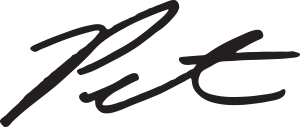
PS – Ready to help position you and your firm for greater success? Check out our Strategic Planning, Leadership and Management Team Training and Development, and Executive Coaching and Mastermind programs.
PSS – Are you a leader who wants to stay relevant and effective and help your firm grow and prosper? Check out the AEC Leadership Today Podcast designed exclusively for you HERE!
PPPS – You can also join the pre-launch community for my new book, The Team Success Ecosystem, and gain early access to key new concepts (like those included in this article!) and events HERE.

Pete Atherton
About the Author
Peter C. Atherton, P.E. is an AEC industry insider with over 30 years of experience, having spent more than 24 as a successful professional civil engineer, principal, major owner, and member of the board of directors for high-achieving firms. Pete is now the President and Founder of ActionsProve, LLC, author of “Reversing Burnout. How to Immediately Engage Top Talent and Grow! A Blueprint for Professionals and Business Owners”, and the creator of the I.M.P.A.C.T. process.
Pete is also the host of The AEC Leadership Today Podcast and leads The AEC Leadership Mastermind.
Pete works with AEC firms to grow and advance their success through modern and new era focused strategic planning, executive coaching, leadership and management team development, performance-based employee engagement, and corporate impact design. Connect with him through the contact link below.

